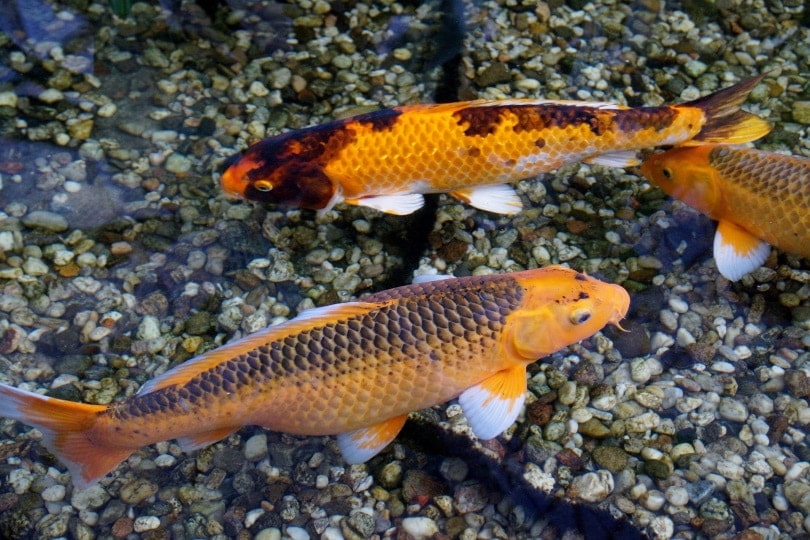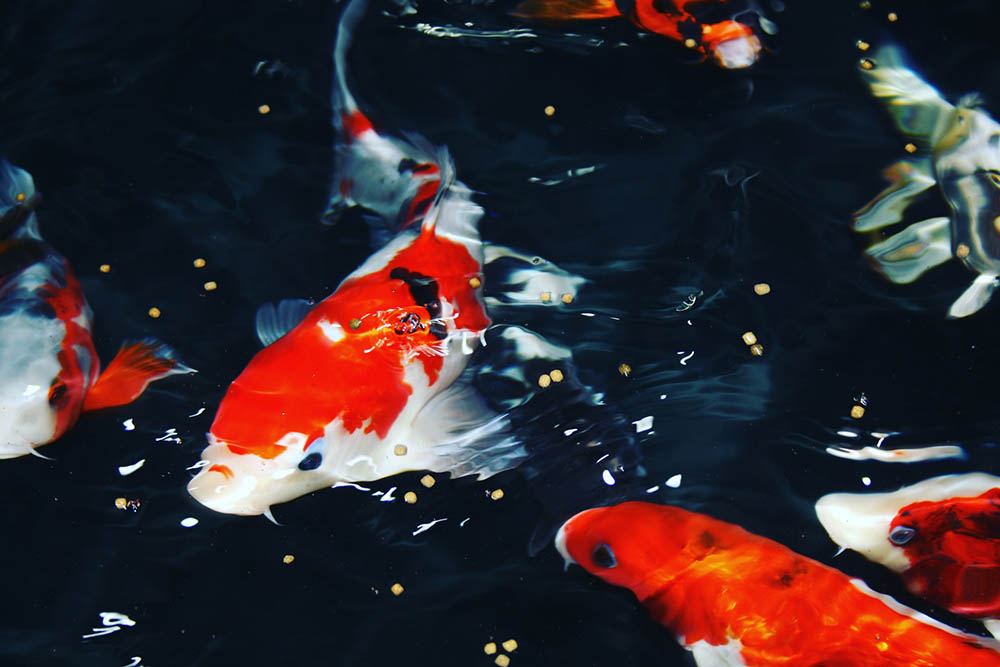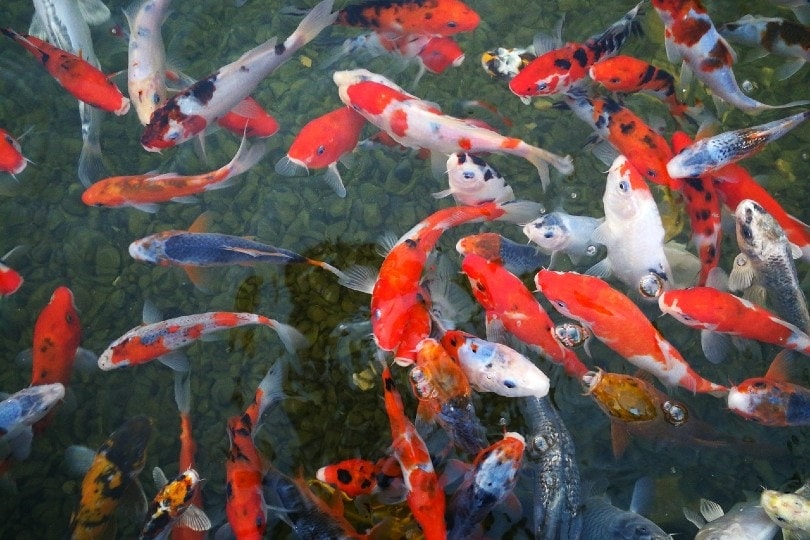How Long Do Koi Fish Live? Average Lifespan, Data & Care Guide

Updated on

Click to Skip Ahead
Koi fish, on average, live around 20 to 30 years in outdoor ponds, although there are reports of one record-breaking koi in Japan reaching the age of 226 years old. Many owners report having koi that live 60 or 70 years, but these cases are extraordinary rather than normal. By providing clean water, plants, and ample room for the fish to swim and grow, you can help promote a long life for your ornamental fish.
Considering that having a thriving pond can also reduce your stress and provide other health benefits, there are a lot of benefits to keeping your koi healthy.
Koi Fish Average Lifespan
It is unlikely that most owners will keep koi fish that reach the age of Hanako. However, the average koi will live to be between 20 and 30 years old. Keeping the pond fresh and clean and stocked with healthy plants, and ensuring that you don’t overpopulate the pond, your koi could live longer.
How Long Do Koi Fish Live in the Wild?
Although in most parts of the world, we are used to seeing koi in ornamental ponds, they live relatively freely in rivers and other waterways in Japan. They are freshwater fish and omnivorous, eating anything they find in the waterways where they live. While very popular in Japan, koi actually originate from China. They were taken to Japan in the 19th Century and were initially kept as a source of food, rather than as a good luck charm or for decorative purposes. Wild koi face a lot more dangers and hazards than captive fish. But they still have a typical lifespan of 15 to 20 years.

How to Care for Your Koi Fish for a Long Lifespan?
Many factors determine how long a koi will live, from genetics to the prevalence of predators in the area. Keeping koi in optimal conditions may mean they live 50 years or more.
1. Feeding & Diet
Diet is critical to a long life. The pond itself should provide a lot of food for your koi as they eat algae, insects, seeds, plants, and even seeds that are naturally found in a healthy pond. However, you can also provide simple meals that are easy to digest and provide a fish’s daily nutritional requirements. This food will supplement the natural food and is especially beneficial in those ponds that don’t have the natural food sources to sustain their koi population.
2. Environment
The water that koi live in is also very important to their health and longevity. They are especially prone to sudden changes in water temperature.
Koi adapt their body temperature according to the water’s temperature and if that temperature changes too quickly, they can go into shock. This is why koi can die in frozen water: not because of the low temperature of the water but because of a dramatic and sudden drop in temperature. Koi can go into a state of torpor, which means their bodily systems slow down, enabling them to survive without food or oxygen for long periods. As long as they have the opportunity to become accustomed to the temperature changes, most koi will survive cold winters.
Koi benefit from having plants in the pond. It provides shelter, regulates temperatures, and also offers natural feeding opportunities.
3. Care
There isn’t much care you can provide koi beyond feeding them and keeping the pond clean. One factor to consider is the number of fish in the pond. Having too many fish means that the fish you have won’t have room to swim freely. Generally, you should provide 10 gallons of fresh water for every three inches of fish, and when stocking a pond with young koi, it is important to remember they can grow significantly over time.

4. Cleaning
Water condition needs to be maintained. This means keeping the pH between 7.0 and 8.0. Use a filtration system to maintain the pH level and ensure there are no significant changes. Remove dead plants and other decaying vegetation because this can significantly impact the acidity or alkalinity of the water. Use additives to help control nitrate and oxygen levels.
5. Pairing/Breeding
Koi will naturally breed when kept in good conditions. They will produce thousands of eggs, which they usually lay in plants and on the bottom of the pond in vegetation. Very few of these eggs will hatch, but you do need to keep an eye on population size so look for signs of eggs and young koi in your pond and consider the effect any population increase will have.
6. Healthcare
- Argulosis
- Columnaris
- Gill Disease
- White Spot Disease
Look for signs of illness, such as the Koi staying near the bottom of the pond, or more food being left than usual. If the water conditions are changing dramatically, this may be caused by fish illness, rather than the conditions causing the illness. Very few vets offer expert koi healthcare so if yours are ill, you will need to approach a local aquatic center or specifically find aquatic veterinarians that can help.
7. Predator Protection
A common cause of death in koi is being hunted by predators. Common predators include domestic cats and dogs, as well as wild animals like possums and raccoons. Depending on where you live, predators may also include large birds. Ensure there is protection over the pond and include some wildlife scarers.

The Life Stages of a Koi Fish
The exact species and genetics of the koi will determine how quickly your koi fish grow and how quickly they progress through the different life stages.
- Egg – Eggs are typically laid in vegetation at the bottom of a pond. A single koi can lay thousands of eggs, but very few of the eggs will hatch and become fry.
- Embryo – When the eggs reach the embryonic stage, they start to separate and grow, before hatching. This typically occurs after 2 weeks.
- Larva – As soon as they hatch, after about 3 weeks, fry enter the larva stage. During this time, they continue to grow. They will become bigger, and they will start to become more independent.
- Fry – Once the fry have the shape of fully developed fish, they enter the fry stage. By this time, they are ready to live independently of their mum and will continue to get bigger. Koi are considered fry at around 4 to 8 weeks of age.
- Juvenile – When the koi is nearly fully grown but has not reached sexual maturity, it is in the juvenile stage. Growth will slow, but the fish will continue to develop biologically. Koi are in the juvenile stage between 16 and 36 weeks.
- Adult – The koi reaches adulthood when it becomes sexually mature. It usually takes around a year to reach sexual maturity, but this does differ in every fish.
How to Tell Your Koi Fish Age
Koi can be accurately aged by counting the rings around the outer scales. One ring forms every 2 years, so if there are 10 rings the koi is 20 years old. Hanako would have had more than 110 rings.
Conclusion
Koi fish can live hundreds of years, but they rarely do. The average pond koi will live between 20 and 30 years, though, which is still a lot longer than many first-time owners expect. To ensure a long life, owners need to provide suitable water conditions, ensure a good diet, and prevent the pond from becoming overpopulated with fish. Good filtration and pH level monitoring are essential, and you will need to protect your pond and fish from predators that might be active in your area.
Featured Image Credit: ivabalk, Pixabay












